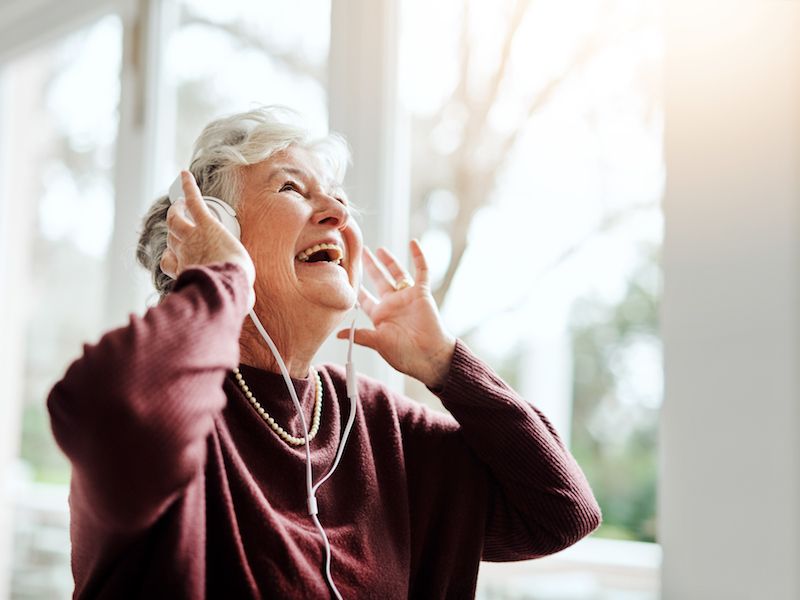
Noise-related loss of hearing doesn’t just affect individuals who work in loud surroundings, like construction workers or heavy metal roadies. It doesn’t even need to be work-related, leisure-related noise exposure can be damaging, also. What type of exposure are we discussing? Loud sounds heard through headphones, whether it’s gaming, streaming video, music, or even an audiobook with the volume cranked up.
You may be alarmed to learn that a mobile device can go that loud. The typical pain threshold for human hearing is around 150 db which is in the range of these devices. Your ears will actually start to hurt at this volume. So what’s the plan to safeguard against this type of noise-related loss of hearing?
It’s important here to consider the volume. An easy shorthand that’s widely suggested is the 60/60 rule: Listen with the volume at or below 60% for 60 minutes or less at a stretch (because the length of sound exposure matters, too).
Create a Setting on Your Hearing Aids For Listening to Music
If you have hearing aids, you’re likely streaming your mobile device right to your hearing aids, so make certain the volume is not too loud or that you’re not trying to drown out other noises with your music. In addition, consult us about how best to listen to music. If you’re a musician or someone who loves music you might have noticed that most hearing aids are created to improve the quality of voices…not necessarily music. We might be able to make adjustments to decrease feedback and noise while boosting some frequency to enhance the quality of sound while listening to music.
Selecting Headphones
When buying headphones there are numerous choices, specifically if you wear hearing aids. It may be a matter of personal preference, but there are some things you will want to think about there as well.
Headphones That go Over The Ears
Over the ear headphones are becoming popular again but you most likely won’t see the old foam covered ear pieces that once came with a walkman. Often shockingly high-priced, they offer a large variety of color possibilities and celebrity endorsements, and yes, exceptional sound quality. And unlike those little foam pads, these go over the whole ear, stopping outside sounds.
Conventional wisdom is that these are safer than in-ear headphones because the source of the sound is further from your eardrum. But because the speakers are larger they are often capable of much higher sound level. Noise cancellation can be a good thing as long as you’re not missing useful sounds like an oncoming vehicle. With that being said, because they cancel out outside noise, you can often reduce the volume of what you’re listening to so it’s not so loud that it will hurt your hearing.
Earbuds
The normal earbuds are well known for poor sound quality, but because they come along with your phone a lot of people still use them. Particularly, with newer Apple phones, it’s simply easier to use the earbuds that came with the device because it probably won’t have a headphone jack.
Earbuds also don’t cancel out noise so the drawback is, you have a tendency to turn up the volume. It’s generally thought that inserting earbuds so close to your eardrum is the primary issue but it’s really the volume.
Occluding or Isolating Earbuds
More comfortable than regular earbuds, models that have a round rubber tip are the choice of many people because they help block outside noise. A seal that stops outside noise from getting in is formed by the rubber tip which conforms to the shape of the ear. Not to sound like a broken record, but these have the same downsides as the other two (volume is the main problem), as well as carrying the same caution as over-the-ear headphones (they can block out warning sounds). And if you wear hearing aids, clearly these won’t work for you.
A number of pairs will probably need to be tested before you find headphones that meet your requirements. Your expectations, acoustically, will be different dependant on what type of use you normally give them. The important thing is to find headphones that make it comfortable for you to enjoy at a safe and secure volume.
Don’t Cut Corners When Dealing With Your Hearing
How can you be certain it’s okay? If you own a smartphone, you can get an app for that, you can download the National Institute for Occupational Safety and Health’s free Sound Level Meter app. You can get other apps, but research has discovered that the accuracy of these other apps is hit-and-miss (also, for unknown reasons, Android-based apps have proven to be less accurate). That motivated NIOSH to develop an app of their own. The app lets you measure outside sounds, but it’s also possible to measure the sound coming from your device’s speakers, this means, the true volume of what’s being sent to your ears. You have to put in a little effort, but putting in place these kinds of protective steps can help protect your ears.

